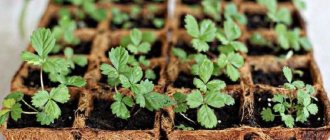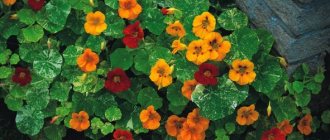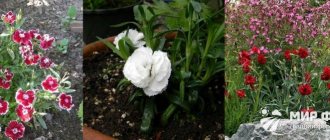Viola is a pretty and delicate plant that can easily fit into any flower arrangement in a garden or vegetable garden. It easily takes root in climate and soil conditions and does not require much time for care.
The best way to get healthy and strong shoots is to plant viola as seedlings
How to grow viola seedlings? Let's take a closer look in this article.
Landing dates according to the lunar calendar
When planting, gardeners all over the world rely on a special calendar – the lunar calendar. It is believed that the Moon has a special effect on plants, causing an increase or decrease in vitality, like the ebb and flow of tides.
This calendar highlights the most favorable and unfavorable days, each month has its own, since everything depends on the date of the full moon and new moon - on these days it is strictly prohibited to do gardening.
So, when to plant viola seedlings? The following periods should be taken into account:
| Month | Favorable days | Unfavorable days |
| January | 17, 18, 19, 23, 24, 25, 26, 27 | 5, 6, 21 |
| February | 6, 7, 8, 11, 12, 13, 14, 15, 16, 17, 23, 24, 25 | 4, 5, 19 |
| March | 12, 13, 14, 15, 16, 17, 19, 20 | 6, 7, 21 |
| April | 6, 7, 8, 11, 12, 13, 15, 16, 17, 29, 30 | 5, 19 |
| May | 8, 9, 10, 11, 12, 13, 14, 15, 16, 17, 21, 22, 23, 26, 27, 28 | 5, 19 |
Another important factor that affects the timing of planting is the climatic features of the region. The territory of Russia is huge, so each region has its own deadlines. Here everything depends on the depth of soil freezing, the abundance or lack of moisture, and solar energy.
These conditions may change from year to year, therefore, starting in early spring, it is recommended to listen more carefully to the forecasts of weather forecasters, who can predict in advance when warming is expected.
Popular types and varieties
To date, over 100 varieties of viola have been bred. But not all of them are planted on Russian territory. The most popular are the following:
| Variety | Description |
| Wittrock | The most popular and widespread type. It has many colors, and some flowers can be of two or three tones. The height of the plant is small - up to 20 centimeters. |
| Alpensee | It differs in the tone of the buds: they have a rich purple hue with a bright yellow core. In addition, the petals have a velvety texture. |
| Bambini | A variety characterized by rich yellow bud petals with red or brown edges. |
| Crystal Bowl White | As the name suggests, this variety has delicate white shades of petals, and the core of the bud is predominantly yellow. |
| Delta Pure Deep Orange | It has a rich orange color of the petals without veins or inclusions. That is why it received such a name. But the main advantage is the large buds, which are several times larger than other varieties. |
| Firnengold | The variety has rich yellow buds with a brown or red core. |
| Majestic Giant II Scherry | The buds of this variety have petals of rich pink or cherry color. Sometimes the edges of the petals are bordered with a gold stripe. |
| Horned or ampelous | Forms an even single canvas of flowers with a diameter of 4-5 centimeters. Fits perfectly into a flower arrangement. Available in various bud colors. |
| Fragrant | The buds form a neat bush, which will also fit perfectly into any flower idea. The buds are, in most cases, white, purple, blue or pink. |
The conditions that are most optimal for a particular variety are usually written on the packaging of the seeds. It is recommended to study them carefully and compare them with the climatic characteristics of a particular region.
Description of the plant
Viola is a herbaceous plant representing the violet family and numbering about four hundred different species. It can be annual or perennial. Both varieties of flowers, which are also known as tricolor violet and pansy, are grown in the garden.
Viola grows wild in countries with a subtropical climate. It can be found in Africa, Australia, America and New Zealand. Some types of pansies grow in temperate continental climates in European and Asian meadows.
The viola forms a compact bush about 15-20 cm high (see photo). A long peduncle (25-30 cm) is formed from the rosette, on which sits a single flower, the diameter of which can reach 5-8 cm. The color of the petals is bright and juicy. It usually includes three colors. But now single-color varieties have been bred.
Viola blooms either in early spring or late summer. In the first case, the flowers fade already in June, and in the second they continue to open until mid-October. Pansies produce fruits in the form of boxes with opening flaps.
Violas are used in landscape design to design long rectangular flower beds (edges) and borders. It is used to frame flower beds and cover empty spaces between medium and tall perennial flowers. Violets with small flowers are suitable for decorating an alpine hill or rock garden. Some varieties are suitable for growing in containers.
Advantages and disadvantages of growing through seedlings
Viola is usually planted through seedlings. This method is considered the most favorable for this plant, since it prevents the death of sprouts in unfavorable environmental conditions.
Young shoots are significantly affected by frost, strong and cold winds, abundance or lack of moisture and solar energy. In turn, seedlings will help prevent this.
The method of growing seedlings has several significant advantages:
- Seedlings allow you to get healthier, more beautiful plants that can take root in open ground.
- Easy to grow and care for. The gardener does not require any special skills or experience.
- The ability to create a unique composition from several varieties. Experienced gardeners can even create different designs or patterns.
The only disadvantages of the seedling method include the additional costs of purchasing cassettes, soil, and various mineral mixtures for bait.
Landing place
Growing viola is not difficult. The flower prefers open areas that do not interfere with abundant light. At the same time, it is better to protect the plant from direct sunlight. The abundance of light has a negative effect on flowering. The buds bloom larger, but wither earlier.
Excessive shading will cause the flowers to become smaller in size and paler in color. The period and duration of flowering of a plant depend not only on the conditions created, but also on the variety used and the time of planting.
Step-by-step instructions for sowing seedlings
There are several planting schemes depending on the time of year:
| Sowing seeds | Flowering time |
| Go straight to the garden or vegetable garden in winter | One of the most common methods. The seeds are hardened in the ground, and in the spring they germinate and flowering soon begins. |
| For seedlings, starting in early March | Flowering occurs two to three months after planting the seeds for seedlings. |
| Directly into the garden or vegetable garden in spring or early summer | Planting begins after night frosts stop and the air temperature becomes constant. The first buds will appear in August-September. After flowering, the plants do not need to be removed, if they are perennial, then they will germinate on their own in April of next year. |
The second, seedling, is considered the best because it allows you to get healthy and beautiful plants that are resistant to environmental conditions.
Let's consider this method in more detail.
Selecting a location
For this plant, choose a sunny, warm place. The best option is a window sill on the south side of the house, where the sun shines most of the time.
If the conditions of the house do not allow such a window sill to be highlighted or cloudy, cloudy weather prevails in the region, then special lamps are used as a light source. They can be purchased at a special gardening store.
The service life of such lamps is about 10-20 years, so the investment will be justified.
Seed selection and preparation
The bag of seeds must be intact, neat, and free from defects and damage. The seeds themselves must also be clean, free from stains and inclusions, and free from the smell of rot and traces of bacteria and insects.
Before planting, the seed must be prepared:
- First of all, they are disinfected, all pathogenic microorganisms, if any, are removed. For this purpose, use a weak solution of potassium permanganate, into which the seeds, wrapped in several layers of gauze, are immersed overnight;
- half an hour before planting, the seeds are placed in growth stimulants. These are special preparations that can be found in gardening stores.
Seed growth stimulator before planting
The quality of the seed largely depends on the quality of the plants.
A healthy viola adapts more easily to environmental conditions and is less susceptible to diseases and pests.
Soil selection and preparation
For seedlings, a ready-made soil substrate for flowering plants is usually used. It is available in gardening stores and is intended specifically for seedlings. The main advantage of the finished composition is the balance of vitamins and minerals necessary for the development of the plant.
Another option is to make your own substrate for planting. It is recommended to mix equal parts of soil from the garden, peat and sand. Experienced gardeners recommend growing seedlings in clean peat, as they believe that this will produce high-quality shoots.
Before planting the material, it is recommended to treat the soil mixture with foundationazole. It will destroy all pathogenic bacteria that can be dangerous to young seeds
Selection of capacity
Both individual containers and one large container are suitable for planting seedlings. But as the young shoots grow, they will have to be planted in separate jars, if they initially grew in one common one.
There must be drainage holes at the bottom of the container to drain liquid.
It is recommended to lay a layer of pebbles or coarse sand as the bottom layer. This will also save the root system from rotting
Direct sowing of viola
The planting order is no different from other plants, so gardeners, even beginners, will not have any problems.
How to sow viola for seedlings? The sequence of actions is as follows:
- prepare everything you need: purchased substrate or homemade soil, individual or shared containers, a wooden stick or toothpick, seed growth stimulator, a spray bottle with water at room temperature;
- soak the seeds in a growth stimulator for 20-30 minutes;
- While the seed is being prepared, make drainage holes at the bottom of the containers, if there are none;
- cover the first layer with coarse gravel or sand;
- pour soil over the sand, leaving 1-2 centimeters on top;
- using a wooden stick, transfer the seeds to the substrate;
- sprinkle on top with a layer of soil 5-7 millimeters thick;
- Sprinkle the surface of the substrate with water.
Cover the container with the seed with polyethylene or cling film. Now the seedlings are ready, all that remains is to put them in a warm place and take care of them in a timely manner. How to do it? Let's take a closer look.
How to care for pansy seedlings
Proper care of seedlings allows you to get beautiful and healthy plants that easily adapt to open ground conditions. But it is important not only to plant the viola correctly, but also to care for it in a timely and competent manner. To do this, you must complete the following steps:
- Viola loves light and warmth. Therefore, it is recommended to keep cassettes with young shoots on the windowsill on the south side of the house. If this is not possible, then ultraviolet lamps can come to the rescue.
- Immediately after planting the seeds in the ground, they are covered with cling film or polyethylene. This allows you to create a greenhouse effect and accelerate germination. But every day the film needs to be removed for 10-15 minutes for ventilation. Better - twice a day.
- Viola does not like excess moisture, as well as its lack. Therefore, it is necessary to water the seedlings as the soil dries out. An abundance of water can lead to diseases of the root system and plant rotting.
- After the first two leaves appear from the ground, the seedlings must be planted in individual containers, if the seeds were initially planted in a single container. The main thing in this matter is accuracy. It is necessary to carefully pry up the sprout along with a lump of surrounding earth and transplant it to a new place.
If you care for the seedlings correctly, then within one or two weeks you will be able to observe young, and most importantly, healthy shoots.
If the seeds do not germinate, most likely the care rules were violated. Less commonly, the cause is an excessively thick layer of soil above the seeds or poor-quality seed material.
Reproduction
Violets are completely unpretentious plants, they are easy to propagate and can be planted even during full flowering. Planting Viola in open ground is possible in any of 3 ways:
- By seeds - in the spring, when the groundwater has gone.
- Seedlings - in the spring, when frost is no longer expected.
- By cuttings - at any time of the warm period.
Planting seeds
Sowing is carried out in prepared soil. The soil must be sufficiently moistened and fertilized; for this you can mix the soil with humus.
Planting is carried out in May, when frost is no longer expected and the groundwater has gone deep. Perennial Violas are sown closer to autumn, so that you can admire the beautiful flower bed in the summer. The seeds are soaked in a growth solution and sown in pre-prepared grooves.
The prepared grooves should not be very deep, about 10 cm. Sow the seeds quite often; after germination, the sprouts can be thinned out, if necessary. Deepen, cover with soil and water well.
Seedling
Typically, flower growers prefer a more reliable method of propagation - seedlings. In order to see all the beauty of the annual violet in the summer, sowing must be done already in February. To grow seedlings, seeds are also sown, but not in open ground, but in special plastic or wooden growing boxes.
The seeds are treated with a growth solution and placed in the soil to a depth of 5 cm, sprinkled with earth and covered with glass or plastic film. The favorable temperature for germination of sprouts is approximately 15 degrees.
The germination of seedlings will not take long and within 10 days the first shoots will appear. After germination, the glass is removed, and the boxes with the germs are moved to a cooler place. During growth, caring for the bush consists of timely moistening the soil and feeding it with nutrients in the form of a mineral solution.
Cuttings
To propagate varietal Viola, the third method is used - cuttings. Juicy green sprouts that have 2 internodes are suitable as cuttings; they are planted separately in a prepared substrate. Before planting, you need to remove all buds.
Until rooting, the cuttings should be kept in the shade and with sufficient humidity; they are usually sprayed to moisturize. After planting in open ground, in a permanent growing place, the sprouts need to be well watered and sprayed with water.
The plant gains color by the end of summer if the cuttings are cut in the spring, and if prepared in the summer, then beautiful buds on the bush will appear only in the next season.
How to plant viola in open ground correctly
The viola is transplanted to open ground starting in mid-May. The main rule is to focus on weather conditions, make sure that there are no night frosts, since they are destructive for young shoots.
Planting in open ground has its own characteristics. Let's take a closer look at the order and main key points.
Preparing seedlings
Proper preparation will allow you to get healthy, strong plants that can easily survive transplantation to open ground and adapt faster to a new location.
Preparing seedlings includes only two points:
- Feeding. About two weeks before the planned transplant to open soils, it is recommended to add mineral fertilizer to the soil for flowering plants. It can be purchased at a gardening store. For seedlings, it is recommended to take fertilizer in liquid form - this makes it easier to determine the desired concentration. Liquid vermicompost works well.
- Hardening. In order for young shoots to quickly adapt to open ground conditions, they need to be hardened off. For this purpose, approximately one to two weeks before the intended planting, it is necessary to take the cassettes with seedlings outside for several hours: in the first days - for 2-3 hours, in subsequent days - for 5-7 hours.
These rules will allow you to obtain high-quality seedlings that can easily adapt to a new location and become a beautiful and healthy plant.
Selecting a location
If viola seedlings love the sun, then the leaves of an adult plant may burn out from solar energy.
It is recommended to plant seedlings in partial shade: a place where part of the day is dominated by sun and the other part by shade. Places under large trees or shrubs with large flowers are ideal for planting. The main thing is to follow the rules of the neighborhood so that other plants do not interfere with the development of the viola.
The soil in the future location should be light, loose, breathable, drained and nutritious - all this affects the quality of future plants. That is why it is recommended to dig up the garden with the addition of crushed charcoal and humus about a month before the intended planting.
You can also apply complex mineral fertilizer - nitroammophoska.
Landing technology
The planting scheme for viola is no different from other plants, so even a novice gardener can cope with this work. The sequence of actions is as follows:
- make holes of small diameter every 20-25 centimeters;
- put a small amount of vermicompost into each hole;
- using the transshipment method, move the young shoots into the recesses;
- cover with soil and compact carefully;
- water the planted plants.
It is also recommended to sprinkle the surface of the earth with ash - this will protect young shoots from various diseases and pests
general information
You may know viola as pansy. Even in the monasteries, these unpretentious, but very beautiful and graceful flowers were cultivated. And over time, breeders got down to business and developed many spectacular garden forms.
Viola has dark, serrated leaves, most often heart-shaped. They are quite large and assembled into a rosette. The flowers can be very small, about 2 cm, but they can also be quite impressive - up to 10 cm in diameter. They are always asymmetrical because the three petals point upward.
Photo: moydom.moscow
Caring for flowers in open ground
Viola needs constant care. It will help the plant quickly adapt to open ground and get used to climatic conditions.
The rules of care are as follows:
- Water as the top layer of soil dries out. Excessive amounts of moisture can lead to diseases of the root system, and too little can lead to yellowing of the foliage;
- After each watering, he recommends loosening the soil around the plant;
- promptly remove weeds near the viola;
- Feed the plant twice a season with complex mineral compounds, for example, “Agricola” or “Fertika Lux”;
- It is recommended to cut off buds that have stopped flowering.
Proper care will help you avoid many problems, diseases and pests.
Possible problems
Viola may be susceptible to pests. Aphids, spider mites, powdery mildew or stem rot are especially common. The action of pathogenic microorganisms slows down the growth and development of flowers, they lose their aesthetic properties and become inconspicuous.
Viola is treated with special compounds - insecticides, which can be purchased at a gardening store.
Viola will become a real decoration of the garden and will fit into any flower arrangement. The main thing is to plant seedlings in a timely manner and care for them, taking into account all the recommendations given in the article.











